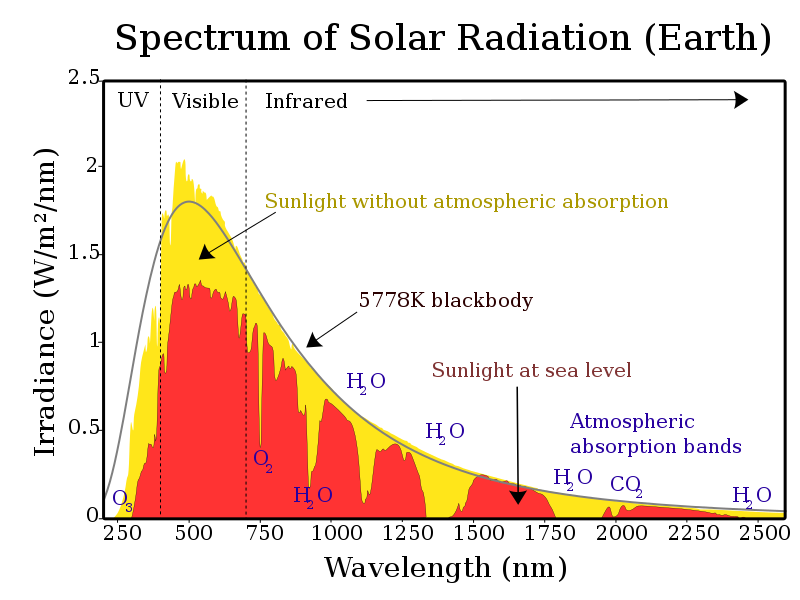Податотека:Solar spectrum en.svg

Големина на овој PNG-преглед на оваа SVG-податотека: 800 × 600 пиксели. Други разделности: 320 × 240 пиксели | 640 × 480 пиксели | 1.024 × 768 пиксели | 1.280 × 960 пиксели | 2.560 × 1.920 пиксели.
Изворна податотека (SVG податотека, номинално 800 × 600 пиксели, големина: 49 КБ)
Историја на податотеката
Стиснете на датум/време за да ја видите податотеката како изгледала тогаш.
| Датум/време | Минијатура | Димензии | Корисник | Коментар | |
|---|---|---|---|---|---|
| тековна | 17:10, 13 мај 2019 |  | 800 × 600 (49 КБ) | Tuvalkin | It's W, not kW, as further discussed: Reverted to version as of 20:57, 21 February 2016 (UTC) |
| 15:13, 25 февруари 2019 |  | 800 × 600 (49 КБ) | Tuvalkin | W → kW, as dicussed | |
| 21:57, 21 февруари 2016 |  | 800 × 600 (49 КБ) | BenRG | Replace 5250°C blackbody (seemingly miscalculated anyway) with standard 5778K blackbody; center-align captions; use Unicode ² instead of SVG superscript to fix rendering problems | |
| 23:21, 7 јануари 2015 |  | 800 × 600 (50 КБ) | Bendhoward | The Y-axis units were changed at some point to W/m^2, which is not correct. The units have been changed back to W/m^2/nm, in accordance with the units of the X-axis. | |
| 23:25, 4 септември 2014 |  | 800 × 600 (50 КБ) | TxBangert | ... changed ^2 to superscript | |
| 23:18, 4 септември 2014 |  | 800 × 600 (50 КБ) | TxBangert | fixed minor errors in how Wikipedia renders svg image | |
| 11:28, 4 септември 2014 |  | 800 × 600 (50 КБ) | TxBangert | Updated the text to bring it in more in line with other European versions of this graph. W/m2/nm on the y axis is wrong. The units are simply W/m2, the x axis is nm. | |
| 15:50, 4 март 2013 |  | 800 × 600 (50 КБ) | Arbeck | Typo corrected - Atmosphere | |
| 16:44, 14 февруари 2013 |  | 800 × 600 (50 КБ) | Arbeck | Typo corrected: visible | |
| 16:44, 14 февруари 2013 |  | 800 × 600 (50 КБ) | Arbeck | Typo correctedvisible |
Употреба на податотеката
Податотекава се користи во следнава страница:
Глобална употреба на податотеката
Оваа податотека ја користат и следниве викија:
- Употреба на ca.wikipedia.org
- Употреба на de.wikipedia.org
- Употреба на el.wikipedia.org
- Употреба на en.wikipedia.org
- Употреба на es.wikipedia.org
- Употреба на eu.wikipedia.org
- Употреба на hak.wikipedia.org
- Употреба на hi.wikipedia.org
- Употреба на hu.wikipedia.org
- Употреба на ig.wikipedia.org
- Употреба на ja.wikipedia.org
- Употреба на ms.wikipedia.org
- Употреба на pt.wikipedia.org
- Употреба на sk.wikipedia.org
- Употреба на sl.wikipedia.org
- Употреба на te.wikipedia.org
- Употреба на uz.wikipedia.org
- Употреба на vi.wikipedia.org









